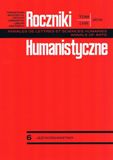Czas sakralny i czas świecki w Sielankach Szymona Szymonowica
The Sacral Time and the Lay Time in Szymon Szymonowic's Sielanki
Author(s): Cecylia GalilejSubject(s): Language and Literature Studies
Published by: Towarzystwo Naukowe KUL & Katolicki Uniwersytet Lubelski Jana Pawła II
Keywords: time in a literary work; types and varieties of time; conceptions of time in renaissance and baroque; idyll; czas w dziele literackim; typy i odmiany czasu; koncepcje czasu w renesansie i baroku; sielanka; archetyp; mit
Summary/Abstract: This paper studies the temporal problem, in particular the conception of the sacral and lay time in Szymon Szymonowic’s most representative work Sielanki (1614). These two types of time: sacral (typically religious – catholic in a narrower scale, and on the other hand broader mythical) and lay (made external above all through the linear time of the world, man and events, and partly as the cyclical and universal dimension of farming) are seemingly opposite, yet they are in fact complimentary. The time of God is manifested only in a relation to man and each time it is referred to the hero’s situation outlined in the work. Now the sacral sphere is evoked by the mythological elements and is revealed by the archetypal code, supratemporal, and collective pattern of human attitudes and behaviours. The lay time is by the nature of things concentrated on each aspect of human life (the time of the world, the nation, and man; the biological time and psychological time). This profound interest in man is in the Sielanki a manifestation of the humanistic in which to perceive the human person. The time is therefore an anthropological category for Szymonowic. With regard to the grammatical and lexical repertoire of temporal lexemes it is limited and conventional. In its overall aspect, however, the writer’s temporal words and descriptive constructions are linked with the multifaceted contextual analysis and present in the Sielanki the whole panorama of temporal types often found in various sets and subtypes of the literature of renaissance and baroque.
Journal: Roczniki Humanistyczne
- Issue Year: 58/2010
- Issue No: 06
- Page Range: 157-183
- Page Count: 27
- Language: Polish

